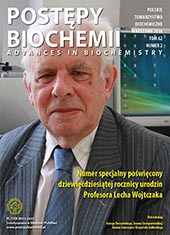Molecular effects of mitochondrial mutations in cytochrome b of complex III and their impact on the levels of free radical production
Abstract
Cytochrome bc1 (mitochondrial complex III) is a common element of several bioenergetic systems. This enzyme catalyses electron transfer from ubiquinol to cytochrome c coupled to translocation of protons across the membrane, which contributes to generation of protonmotive force utilized for ATP production. Cytochrome b, together with cytochrome c1 and iron-sulfur protein (ISP), forms the evolutionarily conserved catalytic core. Transfer of electrons within this enzyme, is facilitated by the movement of ISP domain that allows communication between cytochrome b and cytochrome c1. Mutations in the subunits of catalytic core may cause mitochondrial diseases, however elucidation of their molecular effects in human cells is difficult. For that reason yeast or bacterial systems are used. It was found that some mutations in cytochrome b influence the movement of ISP and, in consequence, the levels of superoxide generation. By exploring the effects of mitochondrial mutations in model systems one can not only learn about molecular basis of diseases but also gain insights about catalytic and side reactions in cytochrome bc1.
Downloads
Published
Issue
Section
License
All journal contents are distributed under the Creative Commons Attribution-ShareAlike 4.0 International (CC BY-SA 4.0) license. Everybody may use the content following terms: Attribution — You must give appropriate credit, provide a link to the license, and indicate if changes were made, ShareAlike — If you remix, transform, or build upon the material, you must distribute your contributions under the same license as the original. There are no additional restrictions — You may not apply legal terms or technological measures that legally restrict others from doing anything the license permits.
Copyright for all published papers © stays with the authors.
Copyright for the journal: © Polish Biochemical Society.




